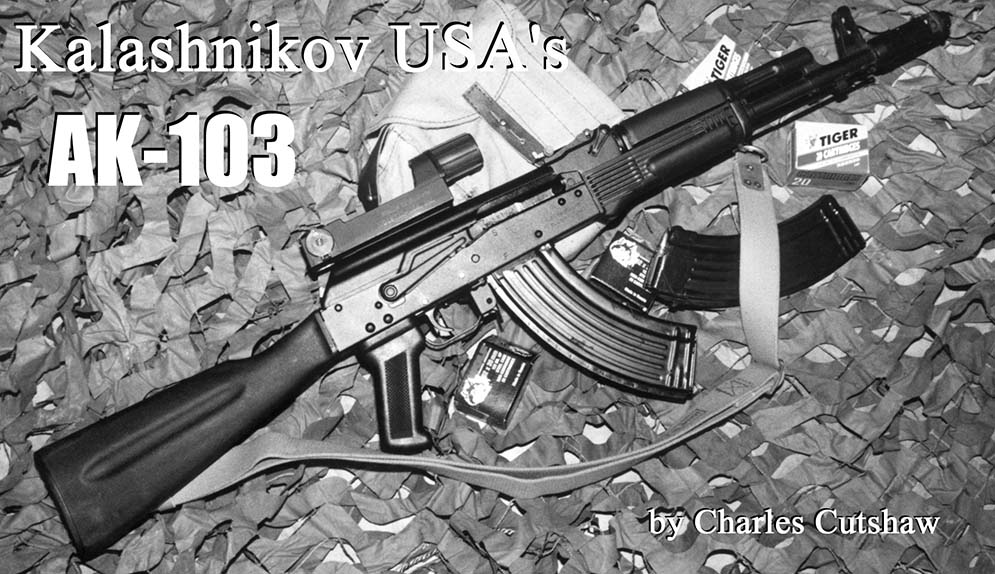By Charles Q. Cutshaw
The ubiquitous AK-47/ AKM and AK-74 have been military small arms mainstays for over 50 years and remain viable, although the Russian military is apparently in the process of replacing the legendary AK with the new-generation AN-94. The AN-94, however, is a far more complex weapon than the AK and it will be many years before the AK leaves Russian military service. Meantime, Izhmash, the “home” of the Kalashnikov Design Bureau and the AK itself has continued to upgrade the venerable weapon. Although the 5.45x39mm was standardized in the early 1970s, the Soviets never completely abandoned the 7.62x39mm M1943 cartridge. So when the next modernization of the AK family was undertaken in the 1990s, rifles in 7.62x39mm were included, along with 5.56x45mm rifles for possible export, although so far no foreign military sales have materialized. The latest in the AK family is the “Hundred Series” of AKs, which also includes the AK-74M. All the rest of the “Hundred Series” carry designations that are variations on the number “100.” There is no AK-100, per se. The actual designations begin with AK-74M and run from AK-101 through AK-108. There is no AK106. Table 1 matches rifles’ designations to their characteristics.
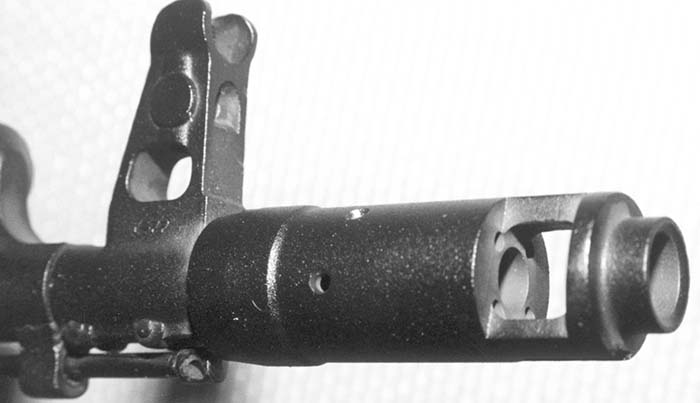
All Russian rifles in the AK-100 Series have folding stocks and are select fire. The US versions have neither of these features. Otherwise, though, the US versions of the AK-100s are virtually identical to their Russian counterparts and cannot be distinguished from them except under close inspection. All Kalashnikov USA rifles in the AK-100 Series have U.S. manufactured furniture of black polymer and are finished in black powder coat. Barrels are chrome lined with four grooves with right hand twist. While Russian rifles in the AK-100 series are shipped with four 30 round magazines and a bayonet, the American version is provided only with two five round magazines and no bayonet lug, much less the bayonet itself! The American AK-103 that we received for evaluation does, however, accept standard 30 round AK magazines.
Izhmash did not pick the AK-100 designation “out of the blue,” so to speak. Most readers are aware that “AK” stands for Avtomat Kalashnikova, while past practice generally has used a number indicating the year of classification for military service, as with the AK-47 and AK-74. The AK-100 designation, however, is derived from a Soviet-era code for the Izhmash Armory, Production Nr. 100. From the information at Table 1, the reader will note that there are a variety of rifles and carbines in the AK-100 series in not only 5.45x39mm, 7.62x39mm, but also in 5.56x45mm. The AK-107 and AK-108, while included in AK-100 series, are quite different rifles than any of the others in that they incorporate a “balanced” operating system derived from the experimental AL-7 rifle of the early 1970s. This operating system essentially eliminates felt recoil, but bears little resemblance to the original AK system.
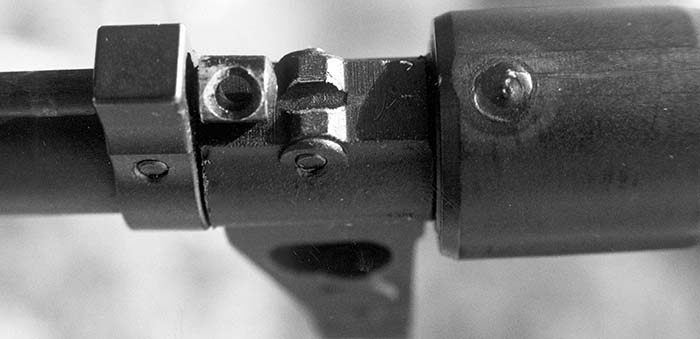
Kalashnikov USA’s AK-103 begins life as a Saiga 7.62x39mm carbine. Saiga carbines are imported by Kalashnikov USA and then contracted out to a custom gun shop for conversion to AK-103 configuration. We actually were sent evaluation AK-103s from two different Kalashnikov USA contractors. The firm that converted our initial AK-103 will remain nameless for reasons that will soon become apparent. The rifles converted by this original shop did not meet quality standards and Saiga carbines are now being modified by DGS, Inc. of Fort Myers, Florida. The original Kalashnikov USA AK-103 rifle that we received for evaluation was disappointing in terms of overall fit and finish, which was rough and uneven. The powder-coated dust cover and receiver were different texture and shade and the overall finish felt like fine sandpaper to the touch. The finish was apparently not very resistant to abrasion, as there were several scuffs and scratches and the safety selector had already worn a deep scratch entirely through the receiver finish. This can be expected after lengthy use, but not in a new rifle. There were several significant assembly flaws, as well. For example, the AK103’s stock retaining screws both had “buggered” slots where the screwdriver had slipped, flared the edges and removed some of the finish. This usually is the result of using the incorrect size screwdriver or overtightening by an amateur gunsmith and we find it hard to accept in a new rifle, particularly one that has a suggested retail price of over $700. The cleaning rod retaining boss, part of the front sight base, did not properly retain the cleaning rod. The rod was loose, rattled and slid back and forth between the retaining boss and the guide on the barrel when the rifle was fired. The receiver cover was also extremely difficult to remove and replace. We have disassembled literally hundreds of AKs over the years, and this is the first instance we have encountered where the cover was difficult to remove. The disassembly button required two separate and distinct motions to free the cover. One first had to push in very hard and then down. Even after this, the cover was difficult to lift. Replacing the cover was slightly less difficult than removing it, but still was more difficult than any AK we have ever seen.
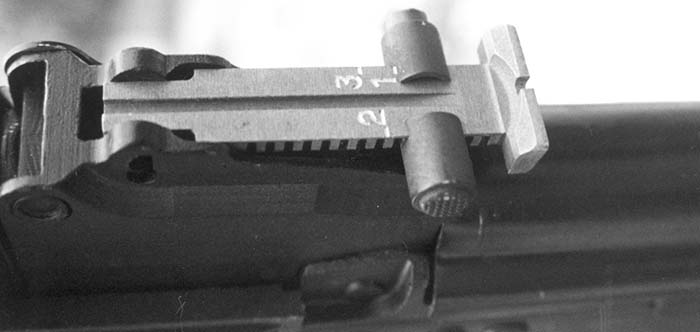
When we called Kalashnikov USA to advise them of our assessment, we were told that this was unfortunately typical of the original contractor’s rifles. Kalashnikov USA further advised us that they had switched to a new firm, DGS, for conversion. The first of the new rifles would be ready for shipment in approximately a week. We were offered a DGS converted AK-103 to replace the earlier rifle and upon receipt, found it to be significantly improved over the original. The powder coating was a slightly lustrous black and was applied uniformly to the all of the rifle’s surfaces. Disassembly of the replacement rifle was typical Kalashnikov, and should need no explanation to the readers of SAR. We should note that the DGS conversion had a 14.5-inch barrel, while the original rifle we received had a 16-inch barrel. The nondetachable muzzle brake of the 14.5-inch carbine brings the overall barrel length to legal specifications, but there is no 14.5-inch barrel in the AK-100 line offered by Izhmash, although a 12.5 inch version designated AK-104 is catalogued by the parent firm. Kalashnikov USA’s rifle retains the AK-103 designation, however, despite its shorter barrel length. We actually prefer the “look” of the rifle we evaluated to the longer barreled version, but a completely “proper” clone of an AK-103 would have a 16-inch barrel not including the muzzle brake.
The AK103 conversion is packed in a hard polymer padded case along with sling, soft canvas field carrying case, oil bottle, pouch for four high capacity magazines, cleaning kit, manual and two Saiga five round magazines. As mentioned, the rifle will also accept the widely available and inexpensive East German and Bulgarian 30 round magazines. Sufficient US manufactured components are included to make the AK-103 legal in its pistol grip configuration. These include pistol grip, stock, gas tube, fire control components and operating rod gas piston. The AK-74 style muzzle brake is fixed in place by drilling and welding. The small spot where this was accomplished is visible at the top of the brake and was the only flaw we noticed in the DGS rifle’s finish. Actual AK100 Series muzzle brakes are, of course, removable. The detent at the top of the brake that normally mates with a spring-loaded retaining pin in the front sight base is not present on the DGS rifle that we received. The AK-103’s muzzle brake is well known as one of the most efficient in the world, and although we did not directly compare it to one of our AKMs, felt recoil was approximately that of a 5.56x45mm rifle, although there was a notable increase in muzzle blast. The AK-103 type muzzle brake is also noted for reducing muzzle rise under full automatic fire.
We should note that conversion from the Saiga to AK103 lookalike did not consist of simply replacing the stock and adding a muzzle brake. The barrel had to be cut two inches, crowned, the front sight relocated and perfectly aligned and a muzzle brake adapter permanently fixed in place. Accommodation also had to be made for the pistol grip, which is not present in the Saiga carbine. This does not merely involve adding a pistol grip, but actually relocating the entire fire control mechanism because the trigger of the Saiga carbine is in the place normally occupied by the pistol grip on an AK carbine. All in all, the DGS conversion was well executed.

The AK103’s receiver is very well made, with heavy-duty rails and internal components and quality welds. Fit of bolt, bolt carrier and overall operation of the reciprocating components was excellent. The bolt carrier and bolt are serially numbered to match the rifle and moved smoothly back and forth with no binding. The two-stage trigger had an initial take-up pull of four pounds with release averaging seven pounds. There was a small amount of backlash, but it should be kept in mind that this is not a precision rifle, but a short to medium-range carbine derived from an assault rifle.
The AK103 functioned flawlessly. We tried the rifle with Wolf full metal jacket and hollow point ammunition, with “Tiger” FMJ and JHP and with Black Hills 123-grain soft point. Tula Arsenal manufactures Wolf, while Barnaul JSC produces Tiger ammunition. These represent two of the three major Russian small arms ammunition manufacturers. Kalashnikov USA is now importing Barnaul ammunition under the Tiger brand name. It is appropriate to note that some domestic producers have ceased manufacture of 7.62x39mm ammunition because of recent low cost imports like Tiger and Wolf. This is not to disparage Wolf or Tiger ammunition; we have found Wolf ammunition to be of excellent quality, reliability and highly accurate in every firearm in which we have used it. Although this was our first experience with Tiger cartridges, we found them to be every bit as accurate as their competitors. For a rifle like the AK103, Russian ammunition seems ideally suited, as both Wolf and Tiger are produced to Russian military standards.
The AK-103’s rear sight is carried over from the Saiga carbine and is graduated only to 300 meters, with range marks indicated by a “1,” “2” and “3.” The remainder of the sight where the longer-range graduations usually are found is simply blank, and while the notches for locking the elevation ramp for longer distances are present, the sight cannot be elevated beyond the 300 meter mark. While graduating the sights of the military version of the rifle to 1,000 meters is wildly optimistic, we believe that having original-type sights would be appropriate to a rifle such as this, as the blank spaces on the rear sight simply do not look “right.” Most purchasers of the AK-103 will probably replace the AK-103’s rear sight with one from an AKM, which we expect should work. The Saiga sight may also be responsible for the fact that the rifle shot extremely low at 100 yards, hitting in the dirt in front of the target frames. This ultimately required that the threaded front sight post be removed and cut off at the base so that it could be screwed down sufficiently to raise the point of aim and zero the rifle’s open sights at 100 yards. Using open sights at 100 yards, we shot groups of approximately three inches using Black Hills, Tiger and Wolf ammunition, perfectly acceptable for a rifle of this class. Using the optional “Cobra-3” reflex sight for rapid fire, squeezing off rounds as quickly as we could fire and reacquire the target, we placed 30 shots inside a 4.5 inch circle at 100 yards.
The AK-103 also came with two optional extras that transform the rifle in our estimation. One option was the venerable PSO-1 4×24 telescopic sight that has been in production for over 30 years and continues to soldier on in Russian service. The PSO-1 that came with our rifle was graduated to 400 meters to accommodate 7.62x39mm ballistics. The other was a “Cobra-3” reflex or “collimator” sight. Both sights are current Russian military issue. All recent Kalashnikov manufactured rifles and shotguns are shipped from the factory in Izhevsk with the Russian military type rail mounting system on the left side of the receiver. This system is quite different than the MIL-STD-1913 rail used by NATO, but functions extremely well. Accessories are attached via a lever and cam system that positively locks the optic in place and ensures return to zero each time the accessory is replaced.
Kalashnikov USA is presently offering a Russian-manufactured side rail that can be mounted to any AK-type rifle, regardless of receiver type. We recommend this type of rail mount for any individual who wishes to equip his AK-type rifle with optics. It is a positive mounting system, identical to the original, so it will accept any Russian manufactured optic. The rail must be precisely placed on the receiver, however, so we recommend that it be installed by a gunsmith.
The Cobra-3 reflex sight is powered by two “AA” batteries and is slightly larger in size than some similar Western sights, but it has capabilities that are not present in most such devices. First, the Cobra-3 returns to the last intensity setting when switched off and back on, rather than to a low or intermediate setting. The Cobra-3 also has four reticle patterns that can be instantly changed by the user by simply pressing a button. These are a “Open T,” inverted red chevron and dot, inverted red chevron only and red dot only. The red dot subsumes less than 1 MOA and is advertised as the smallest red dot available. The Cobra-3 has ten different intensity settings. While the version we received utilizes a Russian side rail mount, a MIL-STD-1913 mount version is also available. Like all such sights, the Cobra-3 is parallax free. For shooters whose eyes cannot focus well on open sights and those who are right handed, but left eye dominant, the Corba-3 is a godsend! We found that both sights hold zero when detached and remounted.
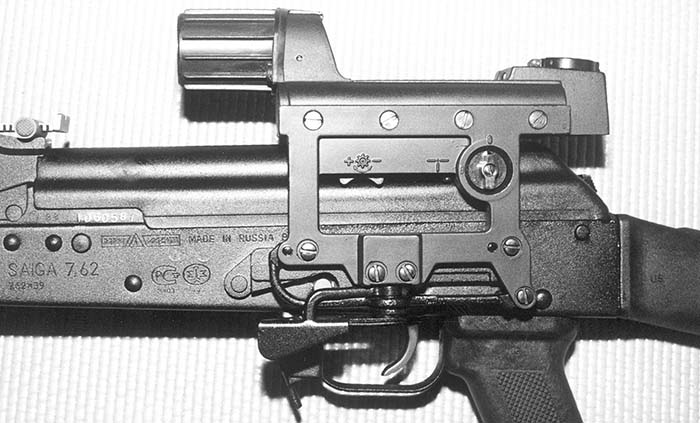
The AK-103’s PSO-1 4×24 telescopic sight is manufactured in Belarus to Russian military specifications, and includes the standard illuminated reticle for use in low light conditions. Unlike the Russian version of the PSO-1, this sight utilizes a single AA battery for power. As mentioned, this version is graduated only to 400 meters with a bullet drop compensator matched to 7.62x39mm ballistics. The PSO-1 sight makes shots at longer ranges much easier and as we mentioned, transforms the AK-103 by offering the shooter a much higher degree of flexibility with his carbine.
The AK-103 is the only true Russian AK available in the United States. While it is a converted Izhmash hunting carbine and not an actual AK103, it captures the essence of the original and is as close as the American shooter, collector and enthusiast can come to owning the real thing in today’s milieu. For that reason alone, it is a worthwhile and desirable firearm. Moreover, the little carbine is fun to shoot! The extremely effective muzzle brake reduces felt recoil to a negligible level and enhances the ability to shoot quickly and accurately. The AK-103 is also an “in your face” statement to the “Barbara Fineslimes” and “Chuckie Schumers” of the world, another cogent reason for owning the AK-103, or for that matter any AK-type rifle. At the same time, the AK-103 offers the traditional AK values of utter reliability, ruggedness and long service life, not to mention the AK’s panache. This replica is also the only such rifle at the moment that offers the Russian receiver side mount that will accept a variety of Russian optics and night vision devices, most of which are commercially available. In addition to the traditional AK merits, the AK103 also inherits all the AK’s disadvantages. These include noisy, cumbersome controls totally lacking in ergonomic design and a length of pull that is best suited for heavily clad short statured troops from one of Russia’s far eastern districts like the Yakut or Chukchi republics. And finally, one has to consider the rifle’s suggested retail price of over $700. Is the AK103 worth its price? That is something that the reader will have to decide, but the fact is that if one seeks a quality AK that was manufactured by the original manufacturer, Kalashnikov USA’s AK103 is the “only act in town!”
Kalashnikov USA
1019 Holbrook Ct, C-3
Port St Lucie, Florida 34952
Tel: (561) 337-3398
Fax: (561) 337-0258
www.weapons-russian.com
| This article first appeared in Small Arms Review V5N4 (January 2002) |



